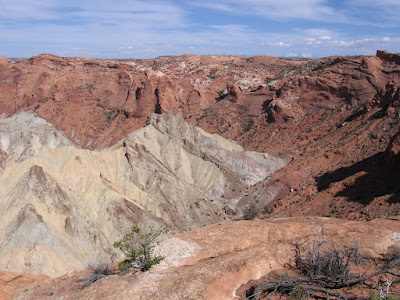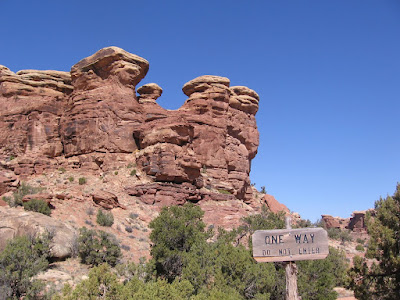 The trail to the heart of the Needles is the Chesler Park Trail. Start at the Elephant Hill Trail Head that is along a side road near the Squaw Flat Campground. The trail heads south with mostly easy walking toward Chesler Park, a wide open area surrounded by the sculpted Needles.
The trail to the heart of the Needles is the Chesler Park Trail. Start at the Elephant Hill Trail Head that is along a side road near the Squaw Flat Campground. The trail heads south with mostly easy walking toward Chesler Park, a wide open area surrounded by the sculpted Needles. This area has a network of trails and there are several options, including Druid Arch and Devils Kitchen. The Elephant Hill 4WD road also heads for the heart of the Needles and can be used to make a loop route. It is about a 6 mile round trip to Chesler Park and back. Druid Arch is an 11 mile round trip. The Needles formations are the Cedar Mesa sandstone layer, a deeper layer than the Entrada sandstone that features the arches found in Arches NP.
 The Canyonlands Park is divided into three districts by the Colorado and Green Rivers. These two famous western rivers flow together in the middle of the park. The Confluence Trail, at the west end of the district leads 5.5 miles to an overlook of the confluence, a view from 1000 feet above the rivers.
The Canyonlands Park is divided into three districts by the Colorado and Green Rivers. These two famous western rivers flow together in the middle of the park. The Confluence Trail, at the west end of the district leads 5.5 miles to an overlook of the confluence, a view from 1000 feet above the rivers. This trail starts off descending into a canyon then climbing out and uses some of the distant 4WD roads towards the end of the trail. The two rivers usually are different in color and the flow of each can be clearly viewed.

On the east side of the Needles District, the Salt Creek and Horse Canyon area has enough water to have supported the people who lived here before the arrival of pioneers. The Salt Creek Trail leads toward Peekaboo Springs and an excellent example of the rock art that can be found in the area.
The hike to Peekaboo is a good destination, and further up Horse Canyon is the Paul Bunyan arch and the Tower Ruins site. Peekaboo Springs is a 5.4 mile round trip. Hiking all the way to Tower Ruin, past the Paul Bunyan Arch is a 9.6 mile round trip. Be sure to carry plenty of water on any of these hikes.
 There are probably many others that are less known and not along any well traveled routes. This one is very good and not along a well traveled route. There are two side by side panels in an east facing alcove. The panel to the right has a gallery of reddish broad shouldered figures. The alcove is near a tamarisk filled creek in some white sandstone outcrops.
There are probably many others that are less known and not along any well traveled routes. This one is very good and not along a well traveled route. There are two side by side panels in an east facing alcove. The panel to the right has a gallery of reddish broad shouldered figures. The alcove is near a tamarisk filled creek in some white sandstone outcrops.

 I started my hike right at the Indian Creek Crossing 2.9 miles down the road. Right at that point is the Indian Creek Falls, about a 20 foot drop off. In early November the Indian Creek was dry except for a brown pool at the base of the falls.
I started my hike right at the Indian Creek Crossing 2.9 miles down the road. Right at that point is the Indian Creek Falls, about a 20 foot drop off. In early November the Indian Creek was dry except for a brown pool at the base of the falls.



 There are several options for hiking to Devils Lane and the other parallel narrow valleys that are referred to as The Grabens. I started my hike at the Elephant Hill Trail Head and hiked the popular route for 2.7 miles, and turned right onto the northern segment of the Devils Kitchen-Chesler Park Loop. This segment continues for 2.3 miles to the Devils Kitchen backcountry campground area. The Devils Kitchen area is at the east end The Grabens. It took me 2:45 hours to arrive here, about 5 miles of hiking.
There are several options for hiking to Devils Lane and the other parallel narrow valleys that are referred to as The Grabens. I started my hike at the Elephant Hill Trail Head and hiked the popular route for 2.7 miles, and turned right onto the northern segment of the Devils Kitchen-Chesler Park Loop. This segment continues for 2.3 miles to the Devils Kitchen backcountry campground area. The Devils Kitchen area is at the east end The Grabens. It took me 2:45 hours to arrive here, about 5 miles of hiking.



 There are two theories attempting to explain Upheaval Dome. The more traditional explanation is that the salt layer below the accumulated sediment pushed upwards. The more recent proposal is that a meteor strike 60 million years ago caused the ¾ mile deep crater.
There are two theories attempting to explain Upheaval Dome. The more traditional explanation is that the salt layer below the accumulated sediment pushed upwards. The more recent proposal is that a meteor strike 60 million years ago caused the ¾ mile deep crater. 









 The three fingered area just below the trail head area is Monument Basin, featuring some tall spires. At the junction of the fingers is the tallest of the monuments, the Totem Pole. The White Rim Road can be seen snaking around the edges of the basin. This road is a favorite with mountain bikers for its endless scenery. The White Rim is about 1000 feet below this view point. The trail travels southwest from the main view point.
The three fingered area just below the trail head area is Monument Basin, featuring some tall spires. At the junction of the fingers is the tallest of the monuments, the Totem Pole. The White Rim Road can be seen snaking around the edges of the basin. This road is a favorite with mountain bikers for its endless scenery. The White Rim is about 1000 feet below this view point. The trail travels southwest from the main view point. 

 The trail head is at the Gooseberry Picnic Area is toward the south end of the main road in Island in the Sky District of Canyonlands NP in southeast Utah. The Gooseberry Picnic Area has two trail choices. The longer Gooseberry Trail leads to the north and down to the White Rim Road. Some of the formations that are visible from the Mesa Arch Trail are also visible here.
The trail head is at the Gooseberry Picnic Area is toward the south end of the main road in Island in the Sky District of Canyonlands NP in southeast Utah. The Gooseberry Picnic Area has two trail choices. The longer Gooseberry Trail leads to the north and down to the White Rim Road. Some of the formations that are visible from the Mesa Arch Trail are also visible here. The trail head is a few miles south of the entrance gate and the Visitor Center on the main park road. The trail has many constructed steps for easy walking and passes through a sandy area of Pinon Pine and Utah Juniper to the arch perched on the rim of Buck Canyon. The canyon floor is 1200 feet below.
The trail head is a few miles south of the entrance gate and the Visitor Center on the main park road. The trail has many constructed steps for easy walking and passes through a sandy area of Pinon Pine and Utah Juniper to the arch perched on the rim of Buck Canyon. The canyon floor is 1200 feet below.

 There is a two track 4WD road leading east off of the graded road for about 2.2 miles from the unmarked trail head, then a right turn that leads for a short distance and the road ends. The walking along the slightly sandy road is easy and there are good canyon views to the east toward the La Sal Mountains.
There is a two track 4WD road leading east off of the graded road for about 2.2 miles from the unmarked trail head, then a right turn that leads for a short distance and the road ends. The walking along the slightly sandy road is easy and there are good canyon views to the east toward the La Sal Mountains. 

 About 12 miles along Utah scenic route 211 there is a sign pointing out Harts Draw Road to the south. The road to Harts Point is the north leading part of the same road. The Harts Point area doesn't have any visitor facilities. I started my hike 11.6 miles along this graded road next to an old windmill on the west side. The turbine for the windmill is in ruins on the ground and has been there so long a sage brush is growing up though it.
About 12 miles along Utah scenic route 211 there is a sign pointing out Harts Draw Road to the south. The road to Harts Point is the north leading part of the same road. The Harts Point area doesn't have any visitor facilities. I started my hike 11.6 miles along this graded road next to an old windmill on the west side. The turbine for the windmill is in ruins on the ground and has been there so long a sage brush is growing up though it.

 The Trail Head at Elephant Hill is also the starting point for popular hikes to Chesler Park and Druid Arch. The 4WD trail is rough for vehicles but the walking is reasonably easy, similar to the hiking trails but wider.
The Trail Head at Elephant Hill is also the starting point for popular hikes to Chesler Park and Druid Arch. The 4WD trail is rough for vehicles but the walking is reasonably easy, similar to the hiking trails but wider.
 The Devil's Kitchen area is a backpacker campground centered around some rock formations that are particularly black with desert varnish, giving the appearance of having been scorched by sooty fires. There are some short trails into these formations that are shady and cool.
The Devil's Kitchen area is a backpacker campground centered around some rock formations that are particularly black with desert varnish, giving the appearance of having been scorched by sooty fires. There are some short trails into these formations that are shady and cool.

